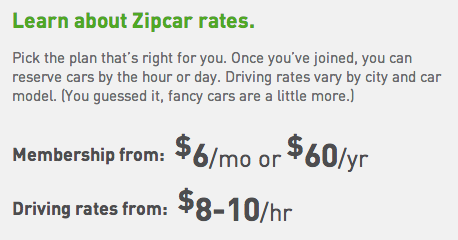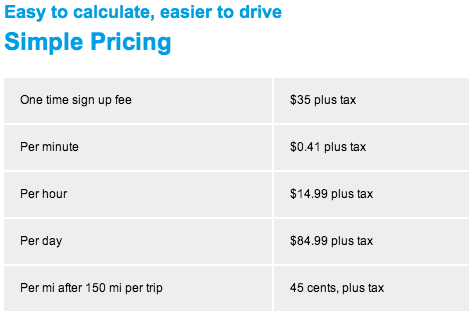Megan and I used to live in a north Seattle neighborhood that saved us tons on rent but didn’t make much sense after we both got jobs downtown, an hour’s commute each way. So we moved to a high-rise apartment building within a 15-minute walk of our offices as well as great restaurants, theaters, and even the tourist sights. The biggest step was when I finally got permission from Megan to sell my car in January (the decision to sell her own car month earlier had been similarly agonizing).
This post covers some lessons on saving money, not just compared to owning your own car at home but also when you’re traveling and want to avoid a traditional rental car.
For background, our monthly cost of owning a car was over $300. This included:
- $30 for street parking
- $40 for gas
- $100 for insurance
- $50 in amortized deductibles and repair costs
- $80 in amortized depreciation
When we moved downtown, we added $150 for garage parking and cut back on street parking and gas a bit, but it was still expensive. Megan wanted to keep at least one car for a sense of freedom (or something like that), but I finally convinced her with the financial sense of paying for transportation only when we needed it. We even experimented with this before moving downtown, but the strategy varies a bit as I’ll explain.
ZipCar
Megan uses ZipCar regularly for work, while I have tried and failed to find much use for it. There are four ZipCars in our building’s garage that are rarely available. Dozens more are within walking distance. It definitely doesn’t work well in our old neighborhood where I had to walk several blocks down a steep hill to the ZipCar’s “home” and return it to its home when I was done.
We’ve experimented with the idea of using a ZipCar for multi-day trips, such as a weekend to Eastern Washington or when our parents are in town. For example, Megan’s family wanted a large car when they came for our wedding last summer, but the rental agency at the airport wanted over $120 a day for a minivan. ZipCar had an Audi Q5 SUV with navigation system for only $90 a day just blocks from their hotel so they wouldn’t need to pay for valet parking, either.
ZipCar works best for trips over 30 minutes, when you need extra space, or when you need to know that the car will be available. (Most of the time. Sometimes seem to have a habit of not returning them on-time.)
Car2Go
When we want to go shopping or visit a park, we’ll usually take Car2Go. It’s a free-floating carsharing service where, unlike ZipCar, you search for the nearest car available on your phone, drive it to your destination, and then leave. I think it’s a good compromise between a bus and ZipCar since finding the car (like a bus stop) is inconvenient, but I have the freedom to drive where and when I want. The only rule is that I have to end my trip within Seattle city limits and in a space that permits parking for two hours or longer (Seattle waives parking fees for Car2Go users).
It is rare that I can use the same Car2Go to get home as I used to arrive. But that can be a good thing. Maybe I had too much to drink and shouldn’t drive. Or maybe we don’t know how long we’ll be shopping. I don’t want to pay for a car I’m not using, which would be the case with ZipCar. It’s also easy to use Car2Go when traveling. There was a reserved Car2Go parking space just outside my hotel in Austin, which made me feel a bit silly that I’d gone to the effort of renting a car and paying for a valet.
Car2Go works great in the suburbs, and it’s usually what I use when I want to visit my friends who still live in the old neighborhood. There are so many cars scattered about, and it’s common for people to drive them home after work. It is cheaper than ZipCar for many trips under 30 minutes.
But it can also be inconvenient. I’ve found that downtown I have more competition and sometimes need to reserve a car, so my meter starts running immediately while I’m still trying to track down the vehicle using the app on my phone. The meter continues to run while I’m stuck in a traffic jam or can’t find a parking space. Finally, the cars have an awful transmission, which makes it challenging to accelerate (even in slow-poke Seattle) and park on steep hills.
Uber
By far our favorite form of transportation these days (besides walking) is Uber. It’s also the most expensive and one reason why I resisted using it for so long. My first Uber ride was only three months ago, but living in the suburbs made hiring a driver much more expensive. A taxi to the airport was $80, and the closest Uber might be two miles away.
Where we live now, it’s a great choice for getting to/from bars and restaurants. Parking a Car2Go in busy neighborhoods is a pain, and I can’t drive one home if I’m not sober. Downtown, the Uber cars swarm like ants. For about $15 I can go almost anywhere I want, and tax and tip are included. I can hail the driver from my phone before I step in the elevator.
I’m still reluctant to use it for the airport all the time because even though we live in a flat-rate zone, it’s steep at $50 each way. So Megan and I have a rule that we take the light-rail (45 minutes, and just four blocks away) for $5 when it’s daylight and use Uber (30 minutes) when it’s dark. It’s more than the average $30 per stay we paid for airport parking, but we are saving a ton compared to the cost of owning our own car. (I’ve had some scheduling issues with my posts this morning, but learn how you can get up to $60 credit as a new Uber user.)
Many people use Uber at their destinations, too, and it’s available in 33 countries at last count. But we aren’t often traveling to cities where this is an option. Both our families live in Uber-free areas. We tend to avoid major metropolitan areas. But having used it on the road a few times it is definitely convenient when you’re not familiar with the area or if you don’t want to call for a taxi. It’s so much easier to just request Uber from an app. Besides, most taxis take credit cards reluctantly, if at all.
Summary
ZipCar, Car2Go, and Uber all have their uses. We prefer ZipCar for the flexibility of renting a car by the hour instead of by the day — but it can still beat traditional rental companies for longer rentals in some circumstances. Car2Go is great for longer excursions where we don’t need a car all day but still want to move faster than a bus. And Uber is for those times when we don’t want any of the hassles of driving our own vehicle. It comes at a premium to hiring a taxi but with premium service, as well. If you decide you have your car delivered to your current location, you may click for source on car shipping services.
These same scenarios apply equally well to travel as to life at home. Our downtown apartment is not much different from a downtown hotel. Now that I’ve sold our car at home I’m also realizing that I probably don’t need to rent a car at my destination, either. Are there still cases where it make sense to rent? Absolutely. And I can rent a car at home, too, when it make sense. But I’m going to be making an effort in future trips to avoid car rentals and see how successful I am with some of these alternatives.





